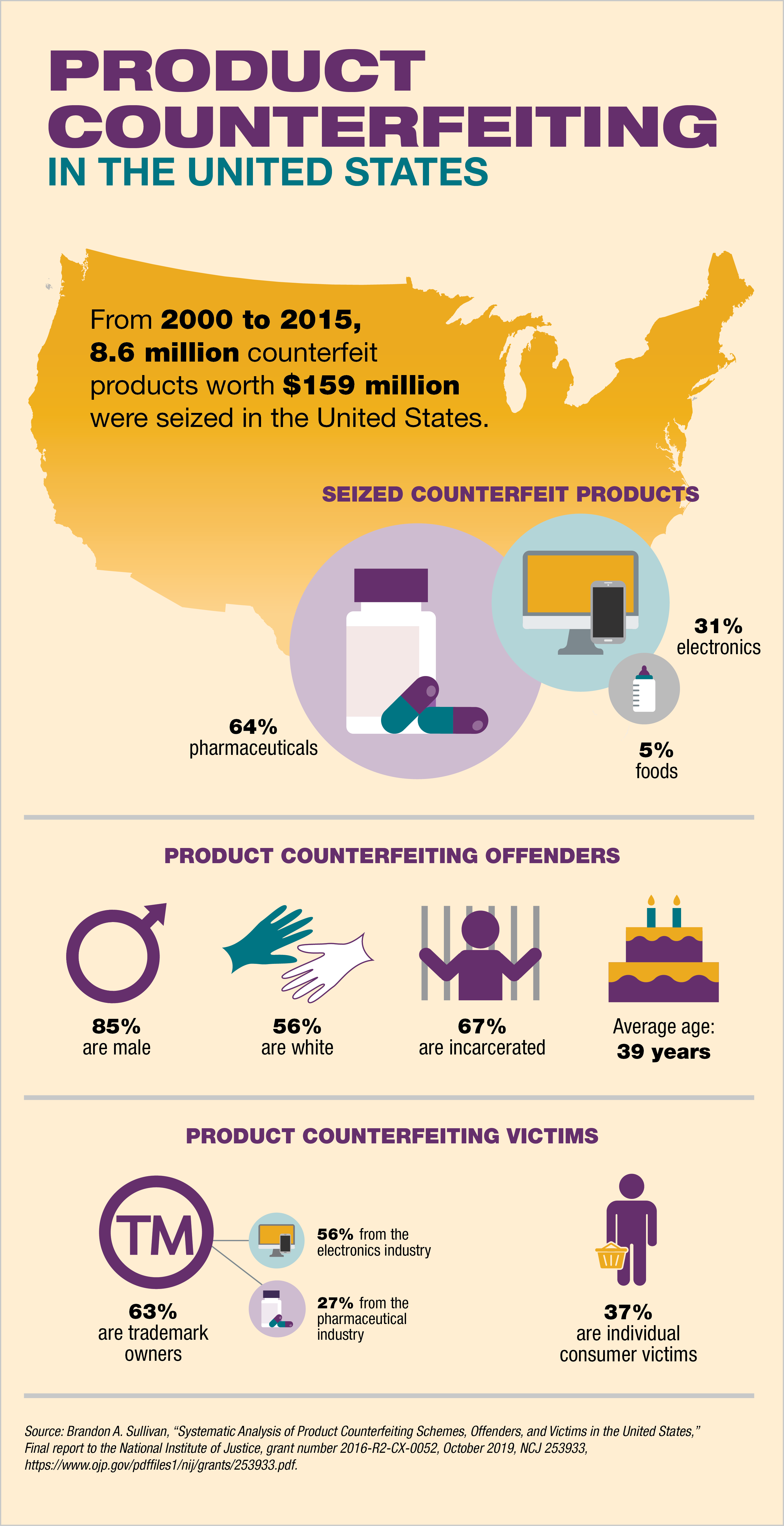Counterfeit products not only cause financial damages, they also threaten public health and safety. There is a lack of reliable data that would enable research to better understand counterfeiting crimes and inform anti-counterfeiting strategies.
To address this information deficiency, Brandon Sullivan – with funding from National Institute of Justice – created a database of counterfeit pharmaceutical, electronic, and food crimes using open-source online information. The database provides information on the characteristics of counterfeit schemes, victims, and persons convicted of associated crimes in the United States from 2000-2015.
The database is intended to be a first step toward the development of an empirical foundation and evidence-driven baseline for future product counterfeiting analyses by capturing information that is publicly available about these crimes. Ultimately, this foundation could aid in developing lessons for law enforcement agencies on preventing, detecting, investigating, and responding to product counterfeiting.
Developing the Database
Sullivan used keyword searches of publicly available online content to identify more than 1,000 product counterfeiting schemes in the U.S. with indictments from 2000-2015. Of these 1,000 schemes, 196 met the inclusion requirements for the Product Counterfeiting Database because they were associated with the pharmaceutical, electronic, and food industries. They then categorized the 196 schemes by if the offense was committed by an individual or business, victim, criminal charge, location of the crime, and specific counterfeited product.
Ultimately, the Product Counterfeiting Database will be archived at the National Archive of Criminal Justice Data and serve as a foundation of data that other researchers will add to and eventually form evidence-based lessons to inform local and federal anti-counterfeiting strategies.
The data can be used to “shed light” on product counterfeiting schemes and “contribute considerably to policy and practice,” said the author.
Product Counterfeiting Database Analysis
Over 8.6 million counterfeit products worth about $159 million were seized from 2000-2015. Most (68%) of the counterfeit schemes were conducted in more than one country and were carried out, on average, over a period of 3.5 years. A little over half (53%) of the schemes in the database involved brick-and-mortar businesses and 44% involved internet sales.
Of the 196 schemes in the Product Counterfeiting Database, 64% involved counterfeit pharmaceuticals, mostly erectile dysfunction drugs; 31% involved counterfeit electronics, predominantly computer hardware and components; and 5% involved counterfeit foods, such as baby formula and dietary supplements.
Most of the 551 individuals convicted of associated crimes in the database were white (56%) male (85%) U.S. citizens (82%) with an average age of 39.2 years. Ninety percent of the them were convicted and 67% were incarcerated for their involvement in counterfeiting schemes. Of the 310 business that committed offenses, 87% of the businesses were owned or operated by an individual person convicted of associated crimes and 37% were categorized as shell companies (companies that only exist on paper).
Sixty-three percent of the counterfeiting victims in the database were trademark owners. Of these 146 individuals, 56% were from the electronics industry and 27% were from the pharmaceutical industry. Very little information about the 54 individual consumer victims was captured by the open-source data collection methods.
Study Implications and Limitations of the Database
The author said the intent of the Product Counterfeiting Database is to serve as a starting point for additional studies of product counterfeiting schemes that will “deepen the understanding of the harms caused by product counterfeiting crimes, the people committing them, and the law enforcement agencies working to address them.”
Specifically, they identified three product counterfeiting research issues that they hope the database will help address in the future:
- Benchmarking the harm caused by product counterfeiting.
- Characterizing what is known about the number, demographics, and roles of the victims and convicted persons involved with these crimes.
- Identifying the types of persons that law enforcement agencies should prioritize in anti-counterfeiting strategies.
The researcher recognized that using only publicly available data to seed the database provides an incomplete snapshot of product counterfeit crimes committed in the U.S. from 2000-2015 — including a lack of information about individual consumer victims. However, he believes the foundation established with the database will inform future anti-counterfeiting studies and strategies.
About This Article
The research described in this article was funded by NIJ grant 2016-R2-CX-0052, awarded to the Michigan State University. This article is based on the grantee final report “Systematic Analysis of Product Counterfeiting Schemes, Offenders, and Victims in the United States” (October 2019), by Brandon A. Sullivan.


